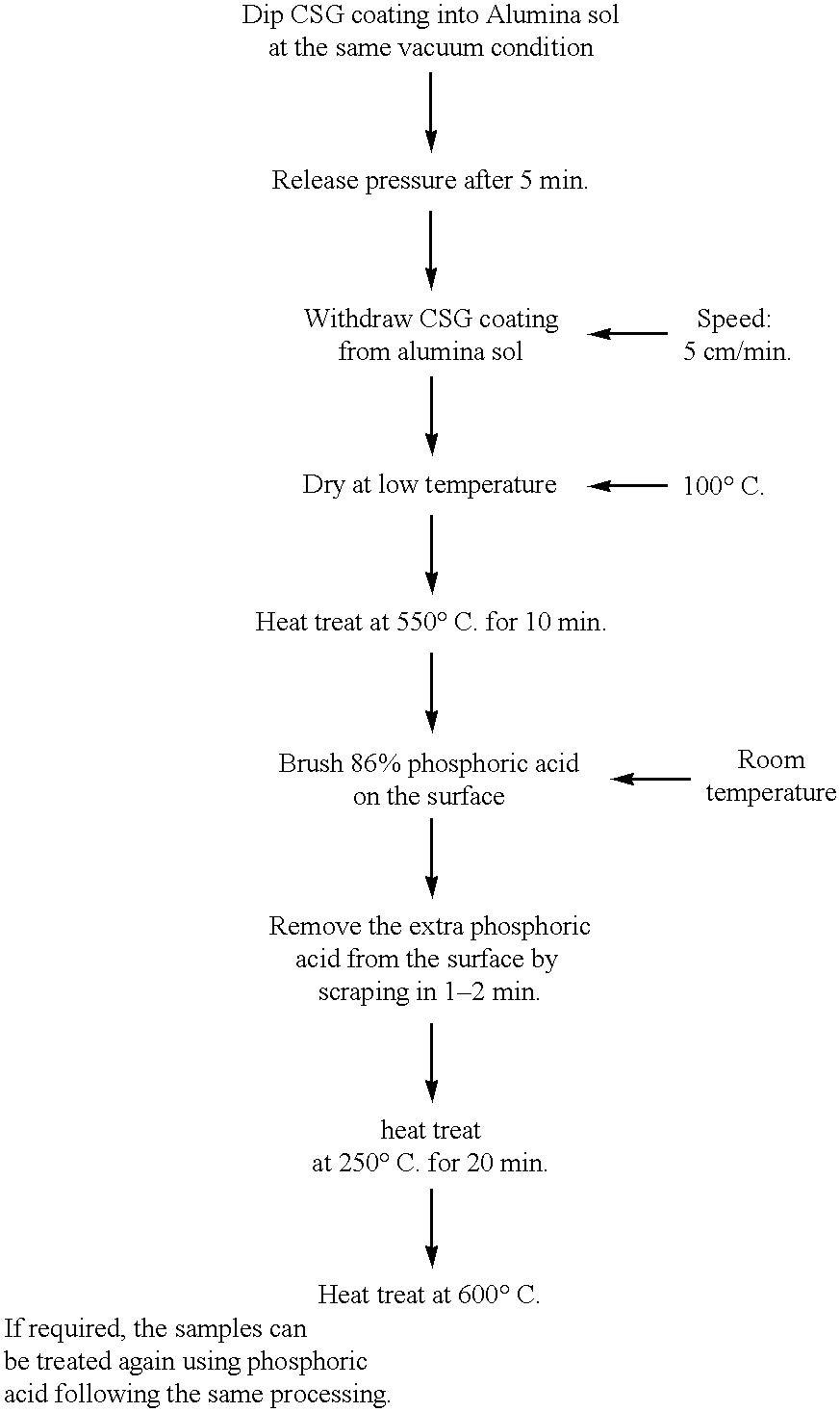Process for making chemically bonded sol-gel ceramics
a technology of sol-gel ceramics and sol-gels, which is applied in the direction of superimposed coating process, liquid/solution decomposition chemical coating, coating, etc., can solve the problems of expensive vacuum system, inability to successfully coat and limited line of sight geometries
- Summary
- Abstract
- Description
- Claims
- Application Information
AI Technical Summary
Benefits of technology
Problems solved by technology
Method used
Image
Examples
example 1
General Example 1
In one example of the invention, alumina sol consisting of a homogeneous medium (H.sub.2 O, isopropanol, or their mix) and alumina colloidal particles dispersed therein is utilised. The hydrated alumina sol clusters are particles approximately 3-5 nm large. Aluminum isopropoxide Al(OC.sub.3 H.sub.7).sub.3 in water (1 Mole per liter concentration) is used as a precursor of the binder phase for deposition of CB-CSG coatings. Hydration of this precursor in acidic environments (pH<4) leads to stable polynuclear cations (a few nm in size) of the formula:
[AlO.sub.4 Al.sub.12 (OH).sub.24 (OH.sub.2).sub.12 ].sup.7+
During processing, the solution is stirred constantly at 90-95.degree. C. for 48 hours and then cooled to room temperature. The shelf life stability of this sol extends to several months at room temperature, thereby making it an ideal precursor for CB-CSG processing. Increasing the pH of 1M alumina sol to above 5 causes a rapid increase in the sol viscosity from 1...
example 2
Use of Hydrated Alumina Sol as a Bonding Matrix Phase of Alumina / Alumina Composite Sol-gel Ceramic Coatings
Aluminum isopropoxide is hydrolyzed in excess water at pH=3 to 5. Calcined aluminum oxide is dispersed in this sol suspension by mixing, followed by ultrasonic agitation to produce a homogenous slurry. The uniform coatings on the substrates were deposited by dip-coating, spin-coating, and spray coating. The single thickness of ceramic coatings is from 6 to 80 .mu.m. The amount of calcined aluminum oxide in dry coating is about 70 to 90%. The composite sol-gel coatings were dried at 50 to 400.degree. C. and densified at 400 to 900.degree. C. The resulting strength of the composite sol-gel coatings is substantially higher as compared to calcined aluminum oxide only processed in a similar way. For example, after heat treatment at 600.degree. C. for 20 min. in air, the surface hardness of a mix of calcined aluminum oxide and aluminum hydroxide sol is 0.6 GPa, as compared to 0.2 GPa...
example 3
Use of Hydrated Alumina Sol as a Bonding Matrix Phase of Alumina / Zircona Composite Sol-gel Ceramic Coatings
As in the above Example 2, calcined aluminum oxide is dispersed together with zircona particles in the sol suspension through hand mixing, followed by ultrasonic agitation. The amount of calcined aluminum oxide plus zirconia is about 80 to 90% of calcined solids. The processing is similar as in the above Example 2. The resulting strength of the composite sol-gel coatings of the calcined aluminum oxide / zirconium oxide plus aluminum hydroxide sol is substantially higher as compared to calcined aluminum oxide / zirconium oxide only, processed in similar way. For example, after heating at 600.degree. C. for 20 min. in air, the surface hardness of the mix of calcined aluminum oxide / zirconium oxide plus aluminum hydroxide sol is 0.6 GPa, as compared to 0.2 GPa of calcined aluminum oxide / zirconium oxide processed at identical conditions.
PUM
| Property | Measurement | Unit |
|---|---|---|
| temperature | aaaaa | aaaaa |
| temperature | aaaaa | aaaaa |
| thick | aaaaa | aaaaa |
Abstract
Description
Claims
Application Information
 Login to View More
Login to View More - R&D
- Intellectual Property
- Life Sciences
- Materials
- Tech Scout
- Unparalleled Data Quality
- Higher Quality Content
- 60% Fewer Hallucinations
Browse by: Latest US Patents, China's latest patents, Technical Efficacy Thesaurus, Application Domain, Technology Topic, Popular Technical Reports.
© 2025 PatSnap. All rights reserved.Legal|Privacy policy|Modern Slavery Act Transparency Statement|Sitemap|About US| Contact US: help@patsnap.com


